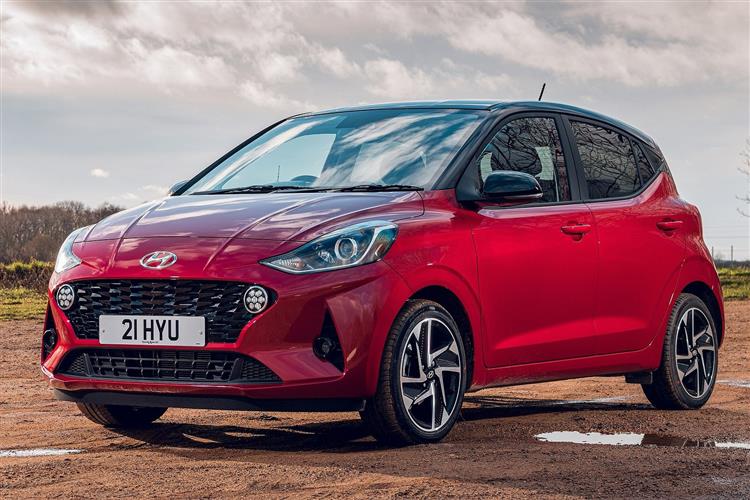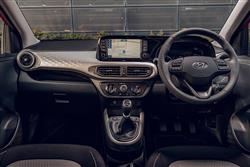How will you view?
This is a sample, showing 30 seconds of each section.
CITY SLICKER? (some text hidden) SECTIONED_new_hyundaii10_2020
By Jonathan Crouch
Introductionword count: 64
We're going to see far fewer city cars on the market in the coming years, which is welcome news for Hyundai, who back in 2020 reaffirmed its commitment to the segment by introducing this third generation version of its popular i10 tiny hatch. It was billed as the most hi-tech city car of its period. It might also be the most complete one too.
Modelsword count: 4
5dr citycar [1.0/1.0T-GDi /1.2]
Historyword count: 364
Some manufacturers will these days tell you that making a tiny little A-segment city car - something less than supermini-sized - just doesn't make economic sense any more. Hyundai disagrees, as you'd expect it might. The Korean brand has long been a European market leader in the city car sector - and aimed to continue that showing with this much improved third generation design. Launched in early 2020, it entered a market vastly reduced in size in terms of competitive offerings. Just prior to this car's introduction, four key rivals - Vauxhall's Viva, the Ford KA+, Suzuki's Celerio, and the Renault Twingo - were discontinued entirely, while combustion-engined versions of the SEAT Mii, the Skoda Citigo and the smart forfour were also deleted, effectively cutting the city car market in half. Which left this i10 - and its identically-engineered cousin the Kia Picanto - fighting against either the Volkswagen up! or Fiat's 500 and Panda models. The Hyundai / Kia conglomerate had pretty much owned this market since 2007 when the introduction of the first generation 'PA'-series i10 fortuitously coincided with the introduction of a UK government's Scrappage Scheme that saw a number of tired old cars being taken off our roads, resulting in a commensurate quantity of buyers with a modest sum of cash in their hands looking for something to buy. The MK1 i10 was an ideal candidate, practical and good looking, plus it didn't cost much and drove well. Sales skyrocketed and for a short while, the i10 was the actually this country's best selling car. It didn't last of course, but this model had established itself in the public consciousness, so market segment leadership was retained when a second generation 'IA'-series version of this design was launched in 2013. That was a very complete product, but it didn't quite have the stylised appeal of some trendy rivals. This MK3 'LA'-series version just might though. It's fractionally bigger, more than a fraction sassier and a great deal more sophisticated than any car this small and affordable has any right to be. It sold in this form until mid-2023, when it was lightly facelifted. It's the pre-facelift models we look at here.
What You Getword count: 398
Design-wise, this MK3 i10 sat 20mm wider than its predecessor, plus there were slimmer headlights and, on higher-spec models, lovely LED spot lamps that sits at the edges of the wider front grille giving the car a slightly more up-market look. 'Go big' is the strapline Hyundai used for this 3rd generation model and indeed it is slightly bigger than its predecessor, though not by much, length having increased by 5mm. More significant is the way that the clean, smoothly muscled body sits 20mm lower than the previous car and incorporates clever visual touches like a neat X-shaped C-pillar. The cabin of the previous second generation i10 model was class-leadingly spacious and practical - but rather dull compared to obvious rivals. Which is why the Koreans tried a bit harder on the stylistic front with this MK3 version. So we were served up intricate corner vents and a trendier silvered mid-level fascia strip, which on top models features a honeycombed 3D pattern in front of the passenger, which is carried on into the door tops. It's certainly very sophisticated inside for an 'A'-segment city car, mainly because of the inclusion of the largest centre-dash touchscreen in the segment. Avoid entry-level trim and you'll find that this display is 8-inches in size. Between the analogue dials in the instrument cluster, there's another much smaller screen (this one black and white) which gives you trip computer data, a digital speedo and safety info. Over-the-shoulder vision is aided by this MK3 design's lower belt line and slimmer C-pillar, plus provided you avoid entry-level trim you get a rear view camera too. Right, let's consider the back seat. Significant here is the news that the wheelbase increased by 40mm over the MK2 i10, pushing the wheels further out to the corners so as to improve cabin space. And that's paid dividends in the back. This i10 was always a good pick if you wanted a city car with an interior nearly as big as a supermini. With this MK3 design, that's even more the case. Hyundai reckons that a couple of big adults will be quite comfortable in the rear - an achievement for a car of this kind. Out back, the decently-sized 252-litre boot is the same size as that of the previous generation model, which means it remains class-leadingly big. Push the 60:40-split backrest down and capacity rises to 1,050-litres.
To see the full road test text contact us on 0330 0020 227
Pictures (high res disabled)

.jpg)
|
.jpg)
|
.jpg)
| |||
.jpg)
|
.jpg)
|
.jpg)
| |||
.jpg)
|
.jpg)
|

|
Scoring (subset of scores)
Category: Small Runabouts
| Performance | |
| Handling | |
| Comfort | |
| Space | |
| Styling, Build, Value, Equipment, Depreciation, Handling, Insurance and Total scores are available with our full data feed. | |



